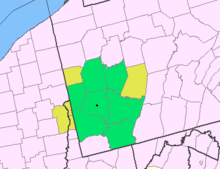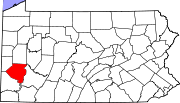world.wikisort.org - USA
Marshall Township is a township in Allegheny County, Pennsylvania, United States. The population was 10,080 at the 2020 census.[2] Marshall Township was named for Thomas M. Marshall, who was instrumental in the township's organization.[3] Since the late 1960s it has been home to a large research and business park.[4]
Marshall Township, Allegheny County, Pennsylvania | |
|---|---|
Township | |
 Shenot Farm Market along Wexford Run Road | |
 Location in Allegheny County and state of Pennsylvania | |
| Coordinates: 40°39′10″N 80°06′49″W | |
| Country | United States |
| State | Pennsylvania |
| County | Allegheny |
| Incorporated | 1863 |
| Government | |
| • Type | Board of Supervisors |
| • President, Board of Supervisors | Thomas Madigan (R) |
| Area | |
| • Total | 15.46 sq mi (40.03 km2) |
| • Land | 15.46 sq mi (40.03 km2) |
| • Water | 0.00 sq mi (0.00 km2) |
| Elevation | 1,194 ft (364 m) |
| Population (2020)[2] | |
| • Total | 10,080 |
| • Estimate (2021)[2] | 10,217 |
| • Density | 570.85/sq mi (220.41/km2) |
| Time zone | UTC-5 (Eastern (EST)) |
| • Summer (DST) | UTC-4 (EDT) |
| ZIP code | 15086, 15005, 15143, 15090 |
| Area code(s) | 724, 878 |
| FIPS code | 42-003-47696 |
| Website | Marshall Township official website |
Geography
According to the United States Census Bureau, the township has a total area of 15.6 square miles (40.4 km2), all of it land. It is part of the North Allegheny School district, along with McCandless and the boroughs of Franklin Park and Bradford Woods. The township participates in the multi-municipality Northland Public Library.
Recreation
Recreational areas in Marshall Township include Altmyer Park, Knob Hill Community Park, Warrendale Park and a portion of the Pennsylvania State Game Lands Number 203.[5][6][7]
Surrounding neighborhoods
Marshall Township has five borders, including Cranberry Township in Butler County to the north, Pine Township to the east, Franklin Park to the south and Economy in Beaver County to the west. The township also surrounds most of Bradford Woods.[citation needed]
Demographics
| Historical population | |||
|---|---|---|---|
| Census | Pop. | %± | |
| 1970 | 2,907 | — | |
| 1980 | 2,594 | −10.8% | |
| 1990 | 4,010 | 54.6% | |
| 2000 | 5,996 | 49.5% | |
| 2010 | 6,915 | 15.3% | |
| 2020 | 10,080 | 45.8% | |
| 2021 (est.) | 10,217 | [2] | 1.4% |
| U.S. Decennial Census[8] | |||
As of the census[9] of 2000, there were 5,996 people, 1,944 households, and 1,675 families residing in the township. The population density was 384.4 people per square mile (148.4/km2). There were 2,018 housing units at an average density of 129.4/sq mi (49.9/km2). The racial makeup of the township was 95.90% White, 1.08% African American, 2.22% Asian, 0.07% from other races, and 0.73% from two or more races. Hispanic or Latino of any race were 0.68% of the population.
There were 1,944 households, out of which 51.2% had children under the age of 18 living with them, 79.4% were married couples living together, 5.0% had a female householder with no husband present, and 13.8% were non-families. 11.9% of all households were made up of individuals, and 4.6% had someone living alone who was 65 years of age or older. The average household size was 3.08 and the average family size was 3.37.
In the township the population was spread out, with 33.7% under the age of 18, 4.5% from 18 to 24, 28.6% from 25 to 44, 25.6% from 45 to 64, and 7.7% who were 65 years of age or older. The median age was 38 years. For every 100 females there were 100.5 males. For every 100 females age 18 and over, there were 95.8 males.
The median income for a household in the township was $102,351, and the median income for a family was $109,376. Males had a median income of $84,871 versus $38,917 for females. The per capita income for the township was $42,856. About 4.7% of families and 5.8% of the population were below the poverty line, including 6.6% of those under age 18 and 6.1% of those age 65 or over.
Government and Politics
| Year | Republican | Democratic | Third Parties |
|---|---|---|---|
| 2020 | 49.3% 3,044 | 49.8% 3,078 | 0.8% 53 |
| 2016 | 54% 2,448 | 42% 1,902 | 4% 159 |
| 2012 | 65% 2,638 | 34% 1,364 | 1% 26 |
References
- "2016 U.S. Gazetteer Files". United States Census Bureau. Retrieved Aug 13, 2017.
- Bureau, US Census. "City and Town Population Totals: 2020-2021". Census.gov. US Census Bureau. Retrieved 20 July 2022.
- "What's in a name? For some, a bit of history". Pittsburgh Post-Gazette. May 10, 1984. p. 1. Retrieved 16 May 2015.
- Hritz, Thomas M. (December 12, 1968), "Warrendale Center will not be closed, State, County agree.", Pittsburgh Post-Gazette, Pittsburgh, PA
- https://twp.marshall.pa.us/parks-recreation/facilities/ "Marshall Township Parks", retrieved 4 November 2018
- https://viewer.nationalmap.gov/advanced-viewer/ "The National Map" retrieved 24 September 2018
- Pennsylvania State Game Lands Number 203, retrieved 24 September 2018
- "Census of Population and Housing". Census.gov. Retrieved June 4, 2016.
- "U.S. Census website". United States Census Bureau. Retrieved 2008-01-31.
- EL. "2012 Allegheny County election". Pittsburgh Tribune-Review. Retrieved 15 October 2017.
- EL. "2016 Pennsylvania general election results". Pittsburgh Post-Gazette. Retrieved 15 October 2017.
- "Election Night Reporting".
На других языках
- [en] Marshall Township, Allegheny County, Pennsylvania
[fr] Marshall Township (Pennsylvanie)
Marshall Township est un township, situé dans le comté d'Allegheny, en Pennsylvanie, aux États-Unis[1],[2]. En 2010, il comptait une population de 6 915 habitants.[it] Marshall (Pennsylvania)
Marshall è una township degli Stati Uniti d'America, nella contea di Allegheny nello Stato della Pennsylvania. Secondo il censimento del 2000 la popolazione è di 5.996 abitanti.Другой контент может иметь иную лицензию. Перед использованием материалов сайта WikiSort.org внимательно изучите правила лицензирования конкретных элементов наполнения сайта.
WikiSort.org - проект по пересортировке и дополнению контента Википедии

